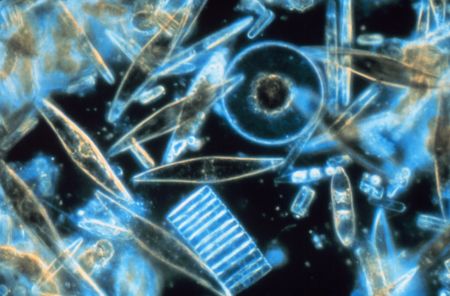2. Ecosystems (5/6)
Phytoplankton growth
Did you know that most algae are so small that sometimes a million of these small plants grow in 1 litre of seawater!
So, now we know that phytoplankton are very small plants that can grow well in the coastal seas, thereby providing all food (also called organic material or biomass) that is needed to have a healthy ecosystem. The phytoplankton consists of a very large number of different algal species.
If you like to observe algae in seawater you need a microscope. Most algae consist of only one cell, although many cells might cluster together in colonies. In the figure above you see that algae can have very different shapes and sizes.
Do you have any idea?
What are the green and brown dots inside each cell?
The growth of algae is determined by the amount of light and the availability of nutrients, nitrate, phosphate and silicate. If all conditions are right, algae can grow very fast, typically doubling the number of cells every day. This happens for a few weeks in spring.
Question: Suppose you have one litre of seawater with 1000 cells of the species Phaeocystis that has on average a weight per cell of 0.5 nanogram. In April growth conditions at 50 degrees North are ideal and each cell doubles every day. How much biomass is available for the food chain after 10 days of unrestricted growth?
Question: Satellites can only observe the amount of Chlorophyll-a pigment in the cells. Typically the mass-fraction of these pigments is 2% of the total mass. How much Chlorophyll-a will the satellite observe after 10 days of spring bloom?
Soon after this bloom period, the growth will slow down and the algal biomass will decrease. The main reasons are:
- The dissolved nutrients in the water are all consumed.
- The zooplankton and filterfeeders will consume the phytoplankton.
- The algae get ill (infected by viruses) and get older and die.

